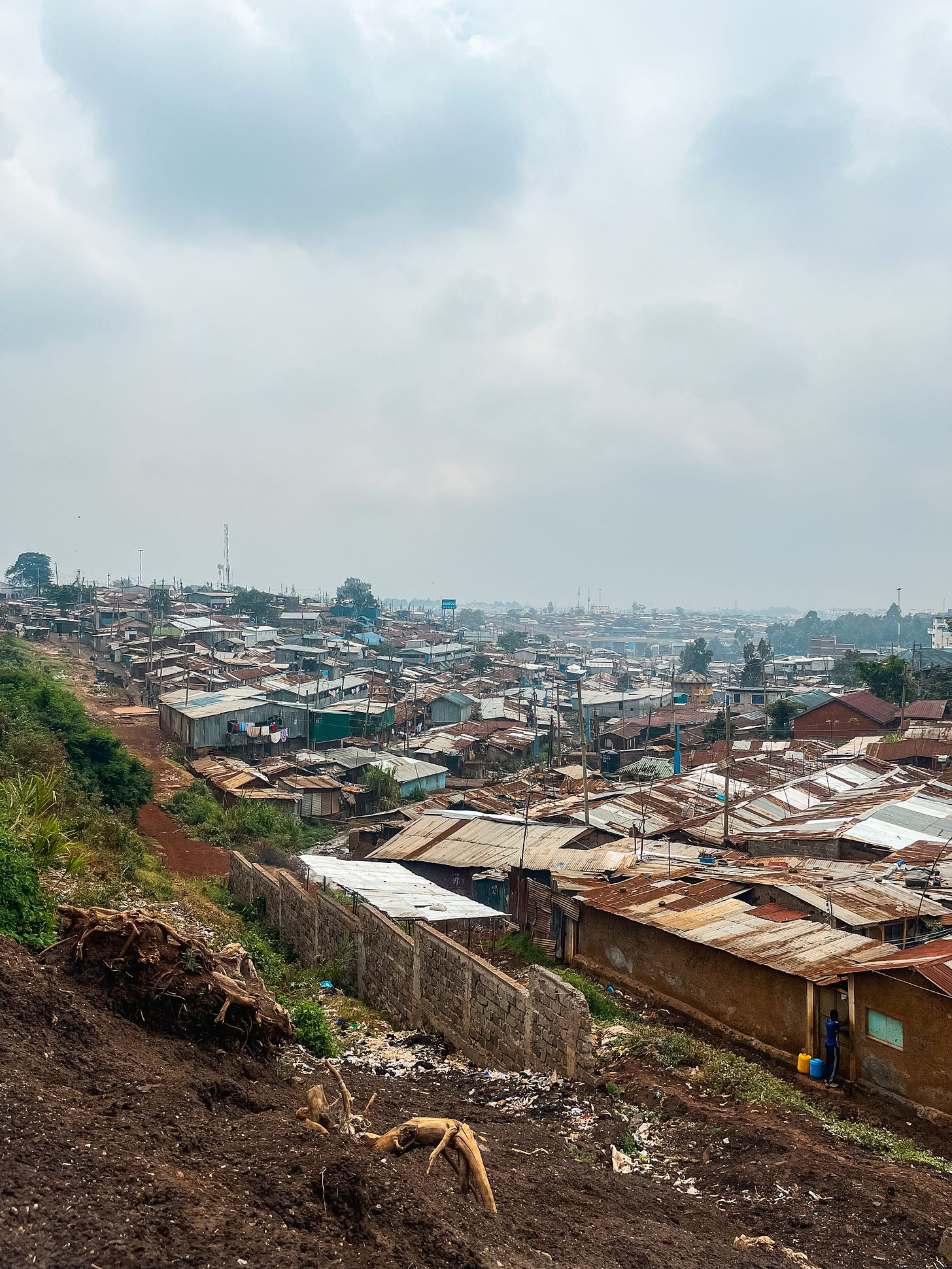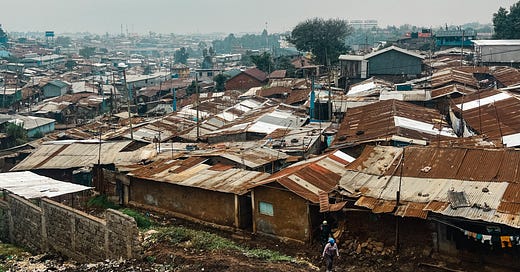In our recent adventure, we did a guided tour through the vibrant streets of Kibera, led by a local NGO Okolea Mtaa Foundation. Okolea orchestrates these tours not only to shed light on the challenges faced by the slum community, but also to generate a modest income that contributes to their development. Let’s just say that walking through a slum in Africa is an experience that engages all of the senses, and is a stark contrast to our reality. As soon as we stepped into the labyrinth that is the Kibera slum, we realized that in some ways it was not how we imagined, and yet in other ways it exactly was. We had heard that the slum is the “poorest and dirtiest” in Africa, so we were probably expecting the absolute worst. That’s not to say that some of the people don’t live in appalling conditions, but it definitely felt a lot less grim and way more friendly and vibrant than the slums of our imaginations. Reality really has a way of shattering stereotypes…
Kibera is derived from the Nubian word “forest” or “jungle”, and is affectionately known as “Chocolate City”, which refers to the brown color of mud and iron sheets that dominate the landscape. Nairobi's modern history began in the late 19th century when it was established as a railway depot for the Uganda Railway in 1899 during British colonial rule. During the colonial period Nairobi was racially segregated, with Europeans living in exclusive neighborhoods, and Africans housed in less-developed areas so-called “native reserves”. “Chocolate City” emerged as the area housing Nubian soldiers from Sudan, who were brought to Kenya to serve the military interests of the British Colonial army. With the development of Nairobi, more and more people moved into the area, particularly for building the Ugandan/Kenyan Railways. Daniel, Elijah, and Stella, siblings who were born and raised in the slum and also happen to be of Nubian heritage, showed us around their home in Chocolate City. It really was an eye-opening couple of hours, and we learned so much about life in the slums and “slum economics”. And yes, you better believe that one of us fed the slum cats, you can guess which one of us it was…

The first and most striking thing is the visual chaos of the slum. Houses and dwellings, homes too over a million people, are jigsawed together with salvaged materials, corrugated iron, and tattered cloths - 50 shades of brown. Clothes lines crisscross between the buildings, which at least brings some color to the harsh surroundings. The government are the land owners in Kibera, as after independence in 1963 it declared Kibera an unauthorized settlement, giving the tenants no rights to their homes or land and absolved the government of any responsibility to provide basic infrastructure. The rent you pay depends on what kind of material your dwelling is constructed from - mud-walled, iron sheet, or concrete. There is a main tarmac road that runs through the middle of Kibera, you could call it the “Main Street”. There is also a train track that runs through the slum. There is a passenger train twice per day as well as multiple cargo trains.
The second most striking thing we noticed, and it’s hard not to, were the heaps of garbage everywhere. With limited access to the government’s waste management services, the population of Kibera grapple with the overflowing piles of trash that is often the cause of water contamination and disease. The smell of burning trash is a fairly impossible to ignore in some parts, but it’s often the only way the residents can address the issue. While the slum definitely wasn’t as “dirty” as we had imagined it would be, the conditions are still rather awful in places.
The conditions are especially awful if you end up being unlucky enough to get hit in the face by a “flying toilet”. Let’s just say that a flying toilet is an unconventional take on waste disposal and that in the most desperate of circumstances, a poo takes flight. When nature calls and plumbing and safety are a luxury, you might just be glad of a plastic bag, which you can then transform into an airborne surprise for unsuspecting neighbors and passers-by. Jokes aside, the toilet situation in Kibera presents significant challenges. Public pit latrines, which mostly are your only option, are often in deplorable conditions - cholera outbreaks are not uncommon. Residents must pay a small fee to use the latrines, and it is said that each latrine is shared by around 50 households.
We were surprised to hear that the slum has electricity. Mind you most of the time unofficially… A lot of inhabitants get their electricity from an illegal power connection, through webs of wires sprawled over the city, hanging precariously on low roofs and makeshift poles. Unsurprisingly, reports of electrocution and house fires are common, but most go unreported to policed seeing as electricity theft is illegal. As well as that, most of the electricity connections are controlled by cartels. The World Bank have in the past tried to electrify Kibera, to bring down the costs of the electricity for the locals, but it turned out that that they could not get the better of the cartels. The same applies to the water supply. Even though there are attempts by the government, as well as several NGOs, to bring water to the different areas, the pipes are often taken over by so-called “investors” who collect the water in tanks and sell it for a small fee.
Contrary to what many people probably think, education does exist in slums across the world, and Kibera is no different. The community is home to both official schools and community-based organizations. These schools, often run by passionate volunteers from NGOs, are bridging the gap between the formal education system and the marginalized slum population. According to our guide Daniel, over 90% of the children in Kibera go to school. In addition to books, looks are also important in Chocolate City. As you stroll through what feels like a maze of small businesses, you'll see small salons and barbershops on every corner - grooming is as important here as it is anywhere else.
Street food is found on every doorstep and street corner in Kibera, and it’s hard not to notice how differently food is priced here compared to the rest of Nairobi. Some popular dishes were chapati (seen above), samosas, bajiya (fried potatoes), and corn grilled over charcoal. The Guardian did a nice piece on the eating and drinking in Africa’s largest slum. Despite the challenges of poverty, residents have managed to establish a strong economic ecosystem. Common businesses include vegetable selling, secondhand clothes selling, food vendors, construction workers, electronic equipment repairmen, shoe restoration shops, and barbershops/salons. The largest market in Nairobi is situated right in the heart of Kibera. As our guide Daniel said, "you can buy everything apart from guns and cars here".
If you ever happen to find yourself in Nairobi, we would recommend taking part in this remarkable tour with Okolea MTAA. The foundations’ mission revolves around alleviating poverty within the Kibera community by providing technical skills and nurturing the talents of the next generation. Current classes offered to the kids through the foundation include dance, art (painting), and sports. Daniel and his siblings Elijah and Stella speak from experience, as their own talents were encouraged and nurtured with the help of foreign donors during their childhood, and now they pave the way for a brighter future - check out their video below! It is also possible to make a direct donation via their website or “gofundme” page.








